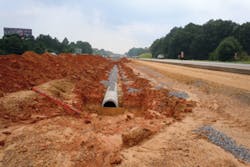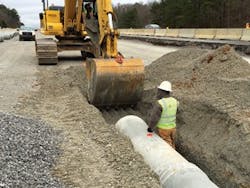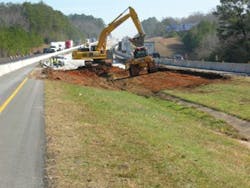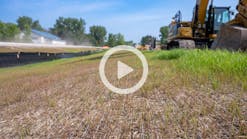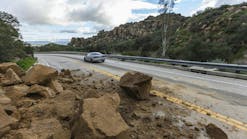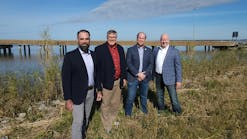Some of the most effective and economical stormwater management practices often go unconsidered as we opt for more traditionally accepted but less effective options. This is evident as we design, teach, implement, and regulate. It is also reflected in our regulations, our handbooks, and even in our trade journals. The management of sediment is the overriding common theme, with erosion running a close second. But is sediment really the problem? It is actually a symptom—a symptom of mismanagement and a symptom of a lack of focus on the right things.
Over the last 12 years or so, the Alabama Department of Transportation (ALDOT) has developed a construction stormwater management philosophy that goes well beyond erosion and sediment control. The approach is affectionately called “the Five Pillars of Construction Stormwater Management.” ALDOT teaches the five pillars to its inspectors, designers, and contractors and incorporates the pillars into its designs and contracts. It has proven to be an effective approach to managing stormwater.
The five pillars include managing communication, managing work, managing water, managing erosion, then managing sediment—in that order. ALDOT starts with an emphasis on the most effective and least expensive pillar, communication, then fills in the rest of the plan and the work with the other four.
The concept begins with an important acknowledgement: Sediment control alone is ineffective. If one chooses to ignore the potential impacts of erosion, the power of water, the possibilities of managing work, and the benefits of communication, there is no sediment control product or practice available that can actually “control” sediment on its own.
This case study is a story of how a group of professionals insisted on effective communication, decided to manage the work, and essentially rendered typical erosion and sediment control practices obsolete for a particular segment of highway work.
The Project
Interstate 20 and Interstate 59 run concurrently for nearly 40% of their route length through central Alabama. The combined interstates carry more than 50,000 vehicles per day in parts of Tuscaloosa County, up to 45% of that heavy truck traffic.
To ease congestion, ALDOT is adding an additional lane in each direction to the median of the four-lane highway. This particular project is about 9 miles long. The work is typical of interstate widening projects: Vegetation and topsoil are stripped; soil is excavated to accommodate the roadway buildup; and the subgrade is compacted to grade before layers of crushed aggregate and asphalt base courses are installed. Asphalt binder and wearing layers follow drainage work, which is performed with the subgrade preparation and before the first layer of crushed aggregate is placed.
With typical construction methods, miles of soil disturbance and long durations of soil disturbance mark these types of projects for potential pollution and regulatory issues. Available area for managing sediment is at a premium in an interstate setting, and erosion control in the active work area usually nonexistent until the first layer of aggregate is in place, months after initial disturbance.
The Water
All of the stormwater runoff from this particular stretch of interstate flows to the southernmost free-flowing stream in Appalachia, Hurricane Creek. Hurricane Creek is of historical, geological, and ecological significance in Alabama. It has been studied by the likes of world-renowned biologist and naturalist E.O. Wilson and is protected today by several environmental advocacy groups. While the creek is certainly a natural beauty, its quality continues to recover from mining and industrial pollution dating back to the 1920s. In addition to measures addressing other pollutants, a total maximum daily load (TMDL) is in place limiting turbidity levels from nonpoint sources to 60.8 nephelometric turbidity units (NTUs).
The Solution
Understanding the significance of the quality of waters entering Hurricane Creek and the task that lay ahead in minimizing sediment loss from the work, local ALDOT staff decided that a different approach to erosion and sediment control was in order. They requested meetings with their counterparts in the ALDOT central office in Montgomery and with the design consultant, AECOM, to explore available options.
In addition to beefing up some sediment control BMPs for redundancy, the team arrived at an unusual work management solution. Rather than allowing the contractor to simply construct the project “the way we’ve always done it,” the team took advantage of ALDOT’s authority to dictate the sequence of construction. Generally, ALDOT prefers to allow contractors to decide how projects are constructed, focusing on minimum requirements and performance as measures of contract compliance.
However, general observation reveals that a contractor’s interests in terms of profit and business management do not always line up exactly with ALDOT’s interest in protecting water quality. Sometimes general observation can be misleading. The team was able to formulate a solution that satisfied the many friends of the creek, but also ultimately benefited both ALDOT and the contractor.
The Communication
As with other large organizations, effective communication at ALDOT is not automatic. With this project being designed by a consultant managed out of Montgomery, and with the contract being administered by a regional field staff to a yet-unnamed low-bid contractor, the local office insisted that the team work very hard to share and consider new ideas. Rather than compromise, which can sometimes result in a product of lesser quality as each side gives up and gives in, the project team reached consensus. By definition, consensus was revealed as participants achieved a better solution than any could achieve on their own.
The new idea was fleshed out, then contract specifications, construction sequence, and plan notes were assembled for review by potential bidders.
Before opening bids, ALDOT also decided to share the plan with environmental stakeholders. Advocacy groups were appreciative of the invitation to hear about the work and to share their concerns. They were pleased that their interests were being considered and acknowledged ALDOT’s leadership and innovation. Representatives of the state’s Department of Environmental Management (ADEM) were also a part of the meeting. In addition to the technical innovation, ADEM also appreciated the outreach effort.
The new plan was communicated to potential bidders in contract documents during a mandatory pre-bid meeting. The priorities and expectations of ALDOT were very well known by the winning contractor as he prepared his bid accordingly. Requirements and intent were further explained and reiterated during a preconstruction conference and onsite stormwater meeting held prior to work beginning.
The Work
ALDOT’s plan was basically to condense the four or five traditional steps described earlier into a single strip-cut-fill-and-stabilize rolling operation that minimized exposed soil.
First, ALDOT told the contractor that median cut and fill work would start at the top of the vertical curves and work toward the sag. Although it may be counterintuitive, this method put as much vegetation between the active work and the median drainage as possible. New drainage would be installed from lower elevations to higher, but only after a protective layer of crushed aggregate was in place.
The contractor began by excavating the median vegetation, topsoil, and subsoil to a specified grade. The subgrade was lowered below that of typical projects to accommodate additional depths of aggregate, which would provide the required structure for the remaining roadbed buildup.
As a dozer pushed, a tracked excavator filled dump trucks with excavated materials. Other trucks delivered crushed aggregate, stockpiling it for immediate backfill. A single motor grader and roller quickly created the stabilized surface of the new subgrade. The continuous parade of loaded trucks helped with achieving compaction. The entire duration of exposure for any given spot was less than a few hours. The contract required that the work area be covered at the end of each shift and before rain. The entire operation could fit into a 200-foot by 50-foot section of median.
Atypical of this kind of work, excavation for median drainage installation was performed in clean and stable material, and pipe was backfilled with clean and stable material, while crew members and equipment worked from a clean and stable platform. Quality drainage work progressed smoothly and productively almost without regard to the weather.
The Rewards
Wintertime work, even in Alabama, can be slow and unreliable. However, as one can imagine, the subcontractor responsible for grading and drainage work has reaped significant gains in productivity. With the exception of during and between near back-to-back events, the contractor’s ability to work has been almost continuous. Working days lost from recovery associated with rain have been significantly reduced.
The contractor has been pleasantly surprised by the benefits of this change in process. Indications are that the contractor would choose to use this method on future projects if allowed, even if not required.
By managing the work, ALDOT reduced the acreage of potential erosion from almost 55 acres to less than one quarter of an acre. The duration of potential sediment loss was reduced from nearly a year to less than a few hours. One need not understand application of the Revised Universal Soil Loss Equation to appreciate the benefits of managing the work on this project. ALDOT estimates reductions in sediment yield for this operation of at least 99% when compared to traditional methods. The source of sediment was essentially eliminated.
The Future
The project is not complete and the final costs have yet to be calculated. However, it is clear that this new method is expensive. But, considering that traffic congestion costs the US more than $120 billion each year—roughly twice the amount of current federal spending on highways—the boost in production alone may be worth it.
ALDOT is considering alternative materials for subgrade cover and structure to reduce costs. The reduction in unnecessary and less-effective traditional sediment control practices should also help to offset expenses. As the word gets out, contractor bids are anticipated to begin reflecting the proven increase in productivity and reductions in contractor risk.
For now, ALDOT and the contractor—and the environmentalist, and the regulator, and the taxpayer—are all simply enjoying the excitement of ALDOT getting well beyond mere compliance as it explores new ways to provide an environmentally sound transportation system in Alabama.
Credit for pushing ALDOT to a better solution is given to Talbert Essary, area stormwater coordinator, and David Hand, ALDOT area operations engineer.